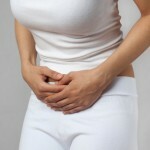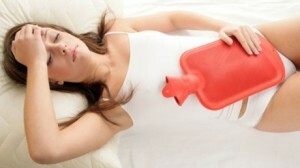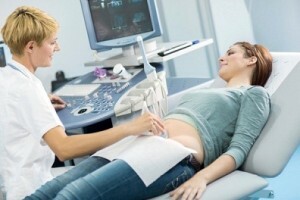Most women suffer from pain with menstruation. This is perceived by many as a natural and inevitable condition caused by excessive contractions of the uterus during PMS.Is this so and what can the painful menstruation signal?
In medicine, there are two terms that define painful menstruation: dysmenorrhea and algodismenorea. These terms combine all the symptoms of painful periods.
medicines Main dysmenorrhea symptoms

symptoms of dysmenorrhea depend on the degree ofseverity and type of pathology. To the alarm signals requiring special attention, it is necessary to relate:
- strong pain with monthly pulling, aching, pulsating nature that occurs a day or two before menstruation and lasts for the first few days;
- weakness, dizziness, unconsciousness;
- back pain;
- nausea, vomiting;
- bloating, diarrhea;
- increased or lowered temperature;
- loss of working capacity, poor health;
- suppressed emotional state, irritability, excessive impressionability.
Dysmenorrhea: primary and secondary
Dysmenorrhea may be primary or secondary. Each species has its own peculiarities of percolation.
1. Primary ( functional) dysmenorrhea - occurs within a couple of years after the onset of menstruation. At the same time, there are no pathological changes in the pelvic organs. First the pain with the monthly is not very pronounced. Over time, there is an increase in the intensity and duration of the pain syndrome.
Primary dysmenorrhea can be expressed in such forms:
- compensatory - the symptoms are expressed constantly and with the same intensity;
- is not compensatory - over time the painful course of menstruation increases.
2. Secondary is caused by organic changes in the pelvic organs. As a rule, it is typical for women over 30 who have already given birth to children. Painful sensations appear a day before menstruation and last all its days. Strong bleeding is characteristic of this pathology.
Causes of dysmenorrhea
Primary and secondary dysmenorrhea have different causes.
Primary dysmenorrhea, according to physicians, is caused by the following reasons:
- A violation of the synthesis of hormones. Because of this, an excess of prostaglandin, responsible for uterine contraction during the PMS period, is concentrated in the body. The high content of this hormone leads to a strong reduction in the uterus. This is what causes uncomfortable pain. Pain syndrome also generates an increased concentration of adrenaline, dopamine, serotonin.
- Another common cause that provokes the appearance of pain with menstruation is the psychological factor. Nervous system disorder, negative emotional state, excessive stress cause tension, lead to acute perception of pain.
- Pain during menstruation can be triggered by insufficient blood in magnesium.
- Endometriosis - in the presence of this disease, PMS becomes painful and plentiful. Pain sensations also occur in the middle of the cycle.
- Pathologies in the development of connective tissue.
- Vascular disorders.
Primary dysmenorrhea is typical for girls who have not yet given birth. After childbirth, in most cases, the hormonal background stabilizes. Pain in menstruation due to a violation of hormonal balance is not such a common problem.
The following factors cause secondary dysmenorrhea:
- Inflammatory diseases - provoked by infection of the ovaries, uterus and fallopian tubes by bacteria.
- Extension of veins in the pelvic region.
- Endometriosis - pain occurs because in the ovaries, as well as the fallopian tubes, the cells begin to grow and flake, which in the healthy body form the walls of the uterus.
- Myoma is a benign neoplasm.
- Adenomyosis is the germination of tissues that form the walls of the uterus into its muscular walls. It is accompanied by severe sharp pain.
- Formation of adhesions.
- . Oncological diseases.
Sometimes, pain with menstruation appears due to the use of unsuitable contraceptives. Most often they occur after the installation of the spiral.

Degrees of development of algodismenorea

The intensity of pain with menstruation can be different. Depending on the level of its severity and character of the course, three degrees of algodismenosis are distinguished:
- The first degree is characterized by moderate pain sensations. There may be a slight general malaise. Performance and activity level, as a rule, remain the same, they do not decrease. A doctor's consultation is desirable.
- Second degree - accompanied by enough with severe pain localizing in the lower abdomen, dizziness, nausea, general weakness. Many women have an emotional state depressed, an unreasonable sense of anxiety arises, and irritability increases. Significantly increases appetite. Performance is impaired, insomnia is possible. Doctor's consultation is necessary.
- The third degree - is expressed by very strong pains, extending to the abdomen, lower back. Significantly worse overall condition, possibly a fever, severe headaches, tachycardia( rapid heartbeat), nausea and even vomiting, diarrhea. Pain with a month is so strong that working capacity is reduced to a minimum. Even taking pain medication does not reduce the intensity of the pain syndrome. If such symptoms occur even for the first time, you should immediately contact a gynecologist. They signal the occurrence of serious health problems. Only the doctor will be able to understand why the painful periods have appeared too painful, having established the causes through accurate diagnosis. Consultation, examination and treatment are compulsory.
Diagnostics features
Understand why you have painful periods of help with thorough diagnosis. To diagnose and identify the cause of the pathology, the doctor can perform the following manipulations:
- gynecological examination;
- blood test and smear;
- ultrasound, hysteroscopy, laparoscopy.
Based on the results, after understanding what is happening during the period, the gynecologist appoints the appropriate method of treatment.
Features of treatment

Treatment of dysmenorrhea can be therapeutic or surgical( in especially severe cases).To achieve the fastest possible positive effect, it must be complex.
The main methods of treatment of primary dysmenorrhea:
- the appointment of analgesics, antispasmodics;
- the appointment of sedatives;
- administration of hormonal drugs;
- homeopathic preparations;
- acupuncture;
- physiotherapy( diadynamic currents, ultrasound);
- the appointment of vitamin complexes;
- normalization of the day;
- maintaining a healthy lifestyle.
The main goal of treatment of secondary dysmenorrhea is elimination of organic pathologies that cause pain in menstruation. In severe cases, surgical intervention is required. To eliminate the pain syndrome, medics are often prescribed tranquilizers and analgesics.

How to reduce pain in menstruation without medicines
There are many ways to reduce pain without using medication. You can use them only after a medical examination, if the doctor has not been diagnosed with pathology.
Effective methods for reducing pain in PMS:
- attach to the stomach "dry heat"( bag with warm sand, hot towel);
- warm foot bath;
- walk in the fresh air;
- special diet, which consists in the refusal of sweet, fatty, caffeinated and alcoholic beverages;
- drinking hot tea with raspberries, mint;
- light abdominal massage in circular motions;
- yoga classes, as well as Pilates.
Timely diagnosis and a well-chosen treatment course can reduce the pain syndrome that occurs during PMS.
